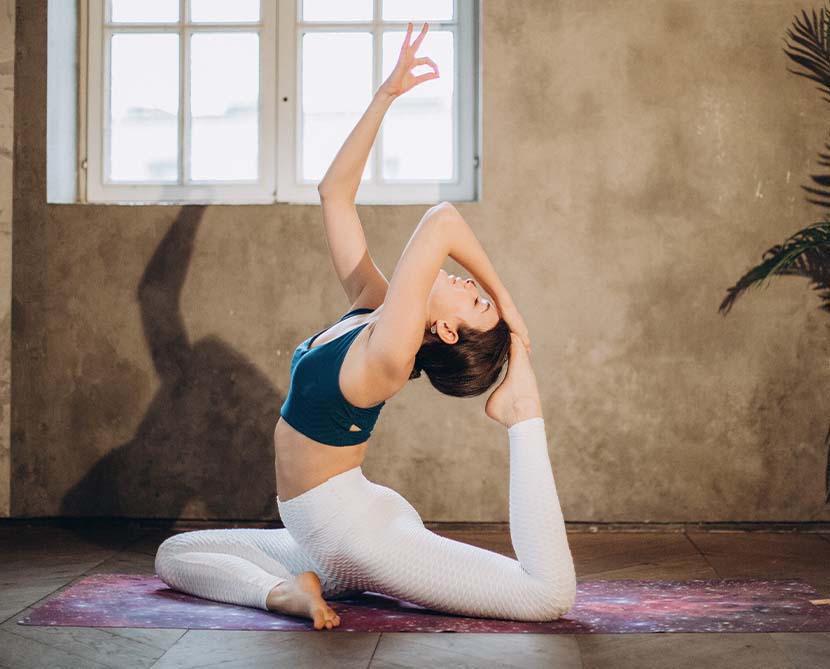
Many of the yoga balance poses are familiar to you. This article will explain the three most well-known ones, including the Tree Pose or Dynamic Dancer Pose. These poses will help you balance your body and allow you to stretch. You will also learn the benefits of each position. Once you're comfortable with them, you can try more challenging poses such as the Eagle Pose.
Tree Pose
Tree Poses may be appealing to you, but what is the secret behind their effectiveness? This balancing posture requires active engagement of your core. It can also help you build a stronger core over time. If you are a beginner, this pose can be challenging. It is best to start with a different balance position (e.g. a chair or a wall) to maintain your balance. Gradually increase the amount of time you stand in the pose.
As you take this posture, remember to stay centered on your invisible plum line. You can strengthen your core and inner thighs by strengthening your core. If you feel unsteady in this position, use a wall to steady yourself or place your hand near the wall for support. Keep your balance! Tree Pose is not easy. If you don't have strong core muscles, it can be even more difficult.
Dynamic Dancer Pose
The Dynamic dancer pose is a sophisticated balancing position. You need to be playful in order for it to work. You start by balancing your body weight on one foot, bending the knee of the other leg, and lifting your heel towards your buttocks. You then reach out and grab the foot with your right hand. Finally, you lift your bent leg up and back into the position.

While this pose can be challenging, it offers many benefits that are comparable to other balancing positions. This pose requires flexibility and a strong lower leg and back. Slip disc users should avoid this as it can put pressure on the lower back. Although many asanas can be challenging, the Dancer Pose has significant benefits. Therefore, it is best to practice it under a qualified instructor.
Eagle Pose
Eagle is a balancing posture that improves flexibility and balance on 2 levels. The left and right sides of the body balance masculine and feminine energy. This pose is excellent for people who feel sick or ill. This pose helps to align your body and mind and can help you refocus, refresh and recharge your mind. If you are experiencing pain or discomfort, try practicing Eagle. This pose offers many benefits including increased breathing capacity, and a lower chance of injury to your knees.
First, ensure your shoulders are square and relaxed. Next, cross your left elbow over the right elbow, so that they meet at the same time. Once you are in the position, press your hands toward the front of the mat so that you can feel an opening between your shoulders. Once you have gotten into the position, it is important to keep your eyes on a fixed location in front of you.
Half Moon Pose
Half Moon Pose is a common balancing pose, and one of the most challenging. Due to the additional stress it places upon the hips, it is extremely challenging. The following are some tips to help you master the pose and avoid falling. To perform Half Moon Pose correctly, follow these steps. You can then practice balance on the floor once you have mastered this pose.
Half Moon Pose, a good stretching exercise for the whole body, is great. This is especially useful if your hamstrings are tight from running or biking. The pose opens your chest and shoulders. This pose is challenging and improves coordination. Start by holding your hands at your waist. Then, step forward with one foot. Reach your back and bend your knees. Then, lower your right foot to the ground.
Keep your front leg bent.

For balalling poses yoga, keep your front knee bent. This is the key to a forward-fold. While it increases flexibility and balance, it can also improve your flexibility. But you need to be careful not to let your knees touch. Do not wait to reach the point where you bend your front knee. Instead, take a few extra inches to fold forward. Simply put, when your front knee is bent forward, your pelvis naturally tilts towards the fold. This puts more stress on your knees.
These balancing poses can be done on one leg while you learn to balance in yoga classes. This will help you stretch your back and improve balance. To protect your knee from twisting stress, keep your front knee bent. To make these poses more challenging, vary the distance between your feet and the front-back alignment. Half-moon poses are a great way to strengthen and balance. The front of your body turns inward toward the long edge of the yoga mat.
Finding your drishti (focal point)
For any balancing pose, your focus point should be the drishti or point of stillness that you keep in view. You can find it by looking at the ground, which is usually about two or three feet in front. You will be able to maintain your center of gravity in the pose even if you look off to the side. Standing poses, such as the handstand require stability in your hips, ankles. This balancing pose requires patience and focus, just like any challenging one.
Yoga practice is incomplete without a drishti. It helps to maintain alignment. You can also use it to maintain good posture during asana. In downward facing dog, your navel is the drishti. In warrior II, the fingertips of you forearm are the drishti. The gaze is directed toward the feet in forward fold while it is directed toward the torso in twists.
FAQ
Why is it important for improving emotional health?
For happiness and well-being, emotional health is crucial. Your ability to perform at your highest level is dependent on how emotionally healthy you are. People suffering from depression often have difficulty working. These people may also suffer from anxiety, panic attacks as well as insomnia. The good news about these conditions is that they can be successfully treated using medication and therapy.
Why is it important that students have a healthy mind?
Students must be healthy mentally to be able both to concentrate on school and to do well academically. Without feeling like yourself, you will not be able perform well at school. Students with depression tend to skip class, which can lead students to have poor grades. This could lead to students dropping out of high schools and eventually going to college.
You should talk to your parents and teachers if you have depression. They'll be able to help you get the care you need.
It is important to remember that not all people with depression need medication. Talk therapy is effective for many people. If you are interested in getting help, you should see a counselor.
What should I do when I'm experiencing mental health problems?
When you have any kind of mental health problem, it's important to seek treatment. Perhaps you've been through trauma or suffered abuse in the past. This could have affected your perception of yourself.
A mental illness such as an eating disorder or addiction could also be present. These disorders can cause serious damage to your life.
You should not attempt to resolve them by yourself. Talk to someone who is familiar with the subject. You can get the support you need from a professional therapist to help you overcome these difficulties.
What causes mental health problems in adolescents?
Adolescence is when we develop our identities. We discover who and where we belong as individuals.
These times are also a good time to make new friendships or romantic connections. These experiences can cause stress.
Stress is normal. But if stress becomes more severe than usual, you should seek medical help.
Although you may think you can handle it all on your own sometimes you need someone to talk to.
Your friends and family members can provide support during times of stress. You may find them able to offer support and help you deal with stress.
For example, you could take up exercise or meditation. Both of these activities can help you reduce stress.
Additionally, you might consider joining a club such as a team sports or church. You'll meet new people, make new friends.
What are some examples of mental-emotional problems?
Mental disorders include any condition that causes significant distress or impairment in functioning. Mental disorders include anxiety, bipolar disorder (depression), schizophrenia, borderline personality disorders, obsessive-compulsive disorders, post-traumatic stress disorder (PTSD), eating disorders, substance abuse and other.
Statistics
- According to the National Alliance of Mental Illness (NAMI), one in five Americans experiences mental health issues which translates to more than 40 million adults a year. (doctorondemand.com)
- Similarly, for positive mental health, there is likely to be substantial agreement about some typical components (e.g., resilience to stress) 6, and controversy about more atypical components (e.g., career consolidation). (ncbi.nlm.nih.gov)
- More than 50% will be diagnosed with a mental illness or disorder at some point in their lifetime.3 (cdc.gov)
- It does have some influence, but not nearly as much as we might think, so focusing less on attaining wealth will likely make you happier (Aknin, Norton, & Dunn, 2009); (positivepsychology.com)
- More than 40 million adults in the United States have an anxiety disorder, but less than 37% of people seek mental health treatment for their symptoms. (talkspace.com)
External Links
How To
How to Improve Your Memory
Memory is something that everyone would love to be able remember better. Unfortunately, memory decline is something we all experience at some point. More than half (50%) of Americans over 65 have some form of dementia.
It doesn't matter whether you're dealing with Alzheimer's, dementia, or other forms of cognitive decline; you have a lot of options when it comes to improving your memory. Here are three simple steps you can try today:
-
Eat More Fruits & Vegetables. Vegetables and fruits are rich in antioxidants, vitamins and minerals as well as fiber and phytochemicals which can boost brain function. They also have essential nutrients that protect against neurological disease.
-
Get Enough Sleep. Poor concentration and memory loss have been linked to sleep deprivation. Get seven to 8 hours of uninterrupted sleep every night.
-
Take a walk. Walking stimulates blood circulation to the brain, which improves memory. Walking is good for your health and helps you look slimmer.